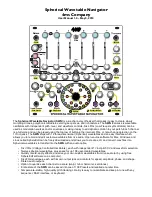
THE COMPONENTS
[
25
]
At low Emphasis levels this circuit often give back whistles-sounding performances, sometime not very useful, but when
amplified you will easily obtain some very distorted and screamy sounds, especially when the incoming audio level is
high. Remember that this is half natural signal, half Emphasis signal.
The goal here was to create a more stable resonance path than the Diode mode, but also to implement this pure electric
distortion above the Resonance path. Audio results vary from a bird chirp to screaming pig with all other farm animals in
the middle. Obviously with a reasonable mix of the two Attitude modality through the signal path very interesting audio
things can happen, especially "tuning" the three cutoffs and modulating them with various CV, like mixed LFOs or S&H
random sequences.
Note that
the auto-oscillation point is placed differently for the two attitude
. In the Transistor way is easy to get it at relatively
low Emphasis settings
because the point of this circuit is to produce audio that have to be drowned into the flowing hi-level
audio signal
. In the Diode way instead the auto-oscillation start late in the pot race and soon it takes on characteristics of
heavy instability, eventually slipping up the Cf. You can have an idea of the auto-oscillation starting point just looking at
the arrows on the two dedicated pictures of the Emphasis pot.
VCO style
If you try to use one or more Vertice's filter like a pure wave generator you will easily make it autooscillate
simply passing the flat position when in Transistor modality. However, since the oscillating circuit is not only
the Transistor-way module but all the passive Steiner's circuitry is involved, don't ever imagine a static auto-
oscillation "à la Moog". It will be very inaccurate both in level and intonation and you can often notice a
sensitive pitch unstability during the flowing of the minutes.
Mixing the three autooscillating VCF togheter can produce very interesting results going from pure sinewave
to talking aliens to RadioAM poltergeist.
I tell you a secret: if you play a bit with autooscillating Emphasis without an injected audio, find some
interesting combinations of Emphasis levels, Cf and Mode, and
then
let the audio, an old good heavy
sawtooth, flow into the filters, often you've made your day. :)
Modulating high value Transistor Emphasis
When in stressed Transistor mode, if modulating the VCA (via switch on the panel) and MCf (via EG rear
out and MCf-CV in) togheter using the built-in EG you can easily find stomping techno beats and screamy
uplifts at LFO values, and going crazy with zombie horror Ktulu-call at audio-range rates. And Ktulu knows
how to play a synthesizer...
Emphasis circuital implementation.
As you can see in the picture saying “level-controllable audio signal feedback” is not a fancy definition. This
is a feedback in the Larsen meaning, just like a mic to amp to mic to amp etc. system. And, just like it, if it is
made with passive and authentic circuitry it can be very difficult to control and tame, but also more intense
and vibrant than, e.g., a digital filter module, the behavior of which is determinated by the Human thought
beside by the Phisycs basic rules. The real circuital difference between the two paths is right here: in the
Classic one the signal travel through an almost passive way, in the Transistor one instead the signal level is
actively controlled by the two little ancient components.
As you may know a transistor is a very simple component, summed up in a easy-to-get image: it is a little
piece of silicon in a small plastic house, which try to act like a valve. How accurate can it be?
Содержание Vertice
Страница 1: ...USER S MANUAL...
Страница 2: ......
Страница 5: ...Dedicato a Walt Bruno e Lorenzina con immenso amore Stefano...
Страница 68: ...Ratio et Cogitatio Unicam Fidem Sunt...
Страница 69: ......
Страница 70: ......
















































